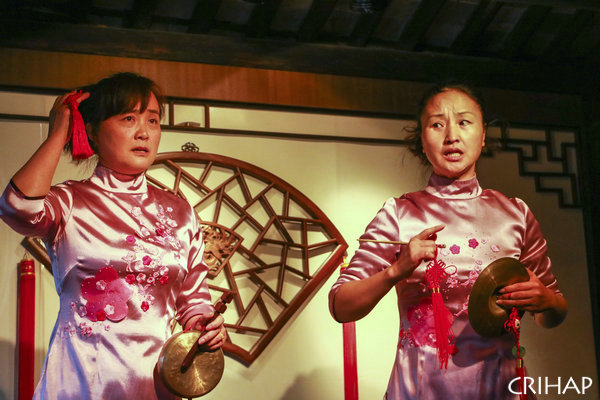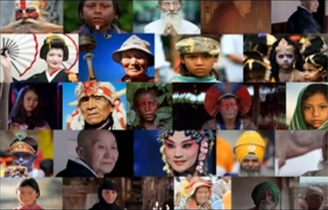Gong and Drum Storytelling

Gong-drum Storytelling was said to appear at the end of the 3rd century in rural areas of Shanghai. Towards the 1910s it had already spread to a wider area, covering even Jiaxing and Pinghu areas of Zhejiang province.
Gong-drum Storytelling, once called Taibao Telling, was actually a mispronunciation of Taibo, a religious-like ceremony in Shanghai rural areas to drive away pests and pray for peace. The ceremony was carried on in the way of entertaining performances such as dialogue, recitation, solo or duet. The content of these performances was generally about folk tales or historical legends which was entertaining rather than religious. As they were played by performers with self-accompaniment of gongs or drums, they were habitually called gong-storytelling or drumstorytelling. As time passes, this form of entertainment develops into an independent folkperformance, and was officially named Gong-drum Storytelling in mid-20th century. During its transmission, the music of the performance was further divided into Eastern School which was popular in Chuansha and Nanhui areas and Western School which was popular in Songjiang and Jinshan areas. Its melodies include Jinping Tune and others.
The main forms of Gong-drum storytelling include divination, storytelling and folk performance. Whereas the first two forms still kept some relation with the religious ceremonies of earlier times, the third one has fully developed into an independent folk performing art, which is the most commonly seen form of the Gong-drum Storytelling today. The basic form of performance is thatthe actors sing and tell stories while striking gongs or drums to make accompaniment for themselves. At first, there was only one person on the stage. Form the end of 1950s on two or more people joined in and more musical instruments were used such as pipa and dulcimer to form a small band. However, the most commonly seen form is still the one-man play accompanied by a small band. Gong-drum storytelling is rich in performing art. A ten-word formula has been summed up through long years of practice, which reads, “telling, narrating, singing, acting, beating (drums by themselves)”; and “hands, eyes, body, method, feet (plus dancing). Othertechniques include performance with hats or fans.
From the end of the Qing dynasty, some storytellers went to tea-houses or storytelling sites and made storytelling their main profession. In the first half of the 20th century, there were nearly 1000 storytelling sites in Shanghai suburbs and neighboring areas. There was also a long list of tales in the storytelling program, including long stories (80 historic and over 100 romantic) and more than 100 “opening passages” of longer stories. To listen to storytelling was once a “fashion” among the youth of that time. According to historical records, the earliest known artist of Gong-drum Storytelling of modern time is Gu Xiuchun, a native of Ertuan township in early 19th century. Up to now, there has been 10 generations of more than 300 storytelling artists.
Address: 81, Laiguangying West Road, Chaoyang District, Beijing, China
Zip Code: 100021
Tel: 86-10-64966526
Fax: 86-10-64969281
E-mail: administration@crihap.cn
NEWSLETTER
Leave us your e-mail address, we'll let you know about current events.


